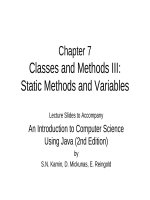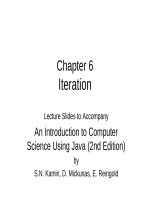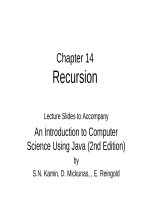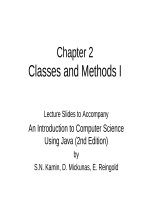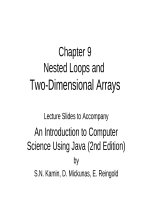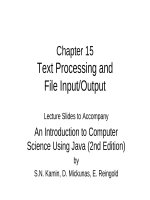Lecture An introduction to collective bargaining and industrial relations (4e) – Chapter 7: Union organizing and bargaining structures
Bạn đang xem bản rút gọn của tài liệu. Xem và tải ngay bản đầy đủ của tài liệu tại đây (776.67 KB, 43 trang )
Chapter
7
Union Organizing And
Bargaining Structures
McGrawHill/Irwin
An Introduction to Collective Bargaining & Industrial Relations, 4e
Copyright © 2008 The McGrawHill Companies, Inc. All rights reserved.
1 3
7 3
Union Organizing
• Negotiations cannot take place until a bargaining
representative has been certified
Normally, a union must win an election to be
certified as the exclusive representative of the
employees
An employer may voluntarily recognize a union if
the union can demonstrate that it represents a
majority of the employees
1 4
7 4
The Organizing Process
• The NLRB is responsible for scheduling
representation elections
• Before the NLRB will schedule an election, at least
30 percent of the election unit must have signed an
authorization card
1 5
Example of informational flyer and
authorization card
7 5
1 6
Why workers might want union
representation
7 6
• For workers to express a preference of unionizing,
they:
• Must be deeply dissatisfied with their current
employment conditions
• Believe that unionization can be helpful in
improving those conditions
• Must be willing to overcome the negative
stereotype of unions held by the population as a
whole
Also, a worker may be angered by a management
decision
1 7
7 7
Union Campaign Practices
• Unions commonly rely on organizers to rally
employee support during an election campaign
They are often paid and fulltime staff who travel
to the site
Group meetings are often held after work hours in
a local church or community room
Sometimes unions have an opportunity to move
around the plant (often these are craft workers) to
spread the message during work hours
• The NLRB can eliminate this practice if it interferes
with the business operation
1 8
An Example of a Union’s Campaign
Literature
7 8
1 9
7 9
Sample of Actual Ballot
1 10
7 10
Management’s Campaign Practices
• Management is rarely a passive observer in the
election process
Management tries to design personnel and other
corporate policies in advance of any election to
dissuade employees from union representation
Businesses do not always have the will or foresight
to put all of their defensive policies in place
1 11
7 11
The Election Unit
• The election unit serves as the basis for the
bargaining unit
It is the group of employees that the NLRB or state
agency determines is eligible to vote
Two main decisions are made to define the unit:
• The range of employees to be included
• Who functions as the supervisor or manager
Since the passage of TaftHartley, supervisors
have been excluded from coverage of the act
1 12
The Scope of the Unit—The NLRB’s
Criteria
7 12
• The scope of the election unit can be a hotly contested
issue
The NLRB and state boards normally consider the
following criteria:
• The community of interests among the
employees
• Effects of alternative units on stability in the
labor relationship
• Sufficient choice for the employees
• History of bargaining at employer
1 13
7 13
Election Unit Determination in Hospitals
• Hospitals have a wide range of distinctions among
professional and quasiprofessional employees
Vast differences in the nature of worker tasks
• The NLRB established separate units for:
Registered nurses and laboratory specialists
Business office and clerical employees
Service and maintenance employees
In 1990, the NLRB reversed itself and narrowed
the units
1 14
7 14
Union Organizing Success Rates
In 2005, unions won 61.5% of elections
• 1,302 out of 2,117 elections
This figure has risen steadily since 1996
In 2005, unions organized 63,700 workers through
NLRB elections, down from 84,00 in the previous
year
Organizing activity and win rates vary by union
New strategies by unions include organizing
professional employees
1 15
7 15
Does the election campaign influence
how workers vote?
• Workers are less inclined to vote for a union if the
election is delayed
Illegal or aggressive behavior of the employer
reduces the likelihood of a first contract
Firms with poor workersupervisor relations and
low wages are more likely to commit unfair labor
practices during election campaigns
1 16
7 16
Union Decertification
The 1947 TaftHartley amendments to the NLRA
prescribed procedures for decertifying a union
Such elections are fewer than certification
elections, but the number is growing and unions
are losing an increasing percentage
In 2005, unions won 33.5 percent of the 331
decertification elections
Despite these data, union members appear to be
satisfied with their unions and leaders
1 17
7 17
The Debate Over Labor Law Reform
• Unions’ low win rate led to the debate over whether
the endorsement of collective bargaining in the NLRA
is being fulfilled
• Advocates of labor law reform argue that penalties
imposed on employers who commit unlawful election
behavior are too weak
They claim procedures for remedying unfair
practices are too protracted, and that employers
close or move operations to avoid unions
1 18
Nontraditional Union Organizing
Tactics
7 18
• Corporate Campaigns
These involve union efforts to bring public,
financial, or political pressures to bear on top
management
In the corporate campaign against J.P. Stevens in
the 1970s, The Amalgamated Clothing and
Textile Workers Union waged a successful
national boycott of their products and threatened to
withdraw union pension funds from banks that had
officers on Stevens’ board
1 19
7 19
The Justice for Janitors Campaign
• The SEIU went outside the NLRB procedures to gain
union representation
• They try to organize on a multiemployer basis and
avoid representation elections by inducing employers
to voluntarily recognize the union
They put pressure on employers that use
subcontractors for janitorial services
Also use alliances with community groups such as
churches to gain public support for organizing
1 20
7 20
The AFLCIO Organizing Institute and the
New AFLCIO Organizing Department
In 1989, the AFLCIO created a new organizing
institute
This was unique with it exclusive focus on
organizing and its clinical programs to train new
organizers
After John Sweeney’s election, it was given a
higher budget
The summer camp funds college interns on
summer union organizing projects
1 21
7 21
A Rank and File Organizing Approach
• Unions that used young, welleducated organizers,
involve extensive communication, and have links to
community groups achieved aboveaverage success
This approach has been labeled a “rankandfile”
style
It contrasts with the more top down, traditional
organizing that relied on appointed organizers and
formal communication strategies
1 22
Representation Election Employer
Neutrality
7 22
• Collective bargaining language regarding union
organizing has become more common
Often included is language regarding employer
neutrality in the organizing process
CWA, UAW, and USWA contracts define this as
“neither helping nor hindering” union efforts
• But they do allow managers to communicate
facts to workers
1 23
7 23
Voluntary Recognition
• The NLRA allows employers to voluntarily recognize
a union
• The law also allows an employer to remain neutral
• In the 1940s and 1950s, it was not uncommon for
employers to adopt voluntary recognition or maintain
neutrality
• Employer voluntary recognition or neutrality has
declined since the 1950s
1 24
7 24
The Southwest Airlines Case
• Founder and CEO Herb Kellerher was viewed as
cooperative with the workforce
This was a key competitive advantage for this
serviceoriented business
Southwest did not oppose unionization
• It is one of the most unionized airlines
Southwest’s success is attributed to flexible
contracts and cooperative relationships
1 25
7 25
The GM Case
• In the 1970s, GM opened nonunion plants in the south and
was successful in keeping the UAW out
But in 1976, the UAW won an agreement that GM
remain neutral in organizing new plants
The UAW won an “accretion” clause, which provided
that any new plants opened that did work traditionally
done by the UAW would automatically be included in
the bargaining unit
The UAW would not cooperate with quality of
working life or other joint activities if the company
continued to fight union organizing
